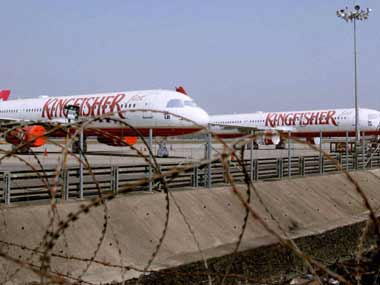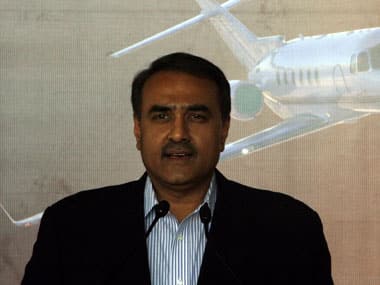Even as Vijay Mallya’s Kingfisher Airlines goes into a death-rattle, the larger question goes unanswered: can any aviation company survive in India? A related question: if the answer is no, what do we have to do to rescue the industry?
Let’s first be clear where the solutions do not lie.
One, bailouts are not the answer. If everyone - from Air India to Kingfisher - has to be bailed out, clearly the industry is fundamentally unviable. The huge losses of almost every single player - Jet, Go Air and SpiceJet, among them - suggest that there is something wrong with the industry’s structure and its operating environment.
Sure, Indigo claims to be profitable; but it could be the exception that proves the rule. In any case, a judgment on its business model will have to await fuller disclosure of its operating structure and financial engineering.
[caption id=“attachment_221277” align=“alignleft” width=“380” caption=“Bailouts are not the answer. If everyone - from Air India to Kingfisher - has to be bailed out, clearly the industry is fundamentally unviable. PTI”]
 [/caption]
[/caption]
Two, the problem is not high aviation fuel prices, per se. In India, aviation turbine fuel (ATF) is far cheaper than automobile fuel, but we don’t hear screams of blue murder from the latter segment. The airlines clearly don’t know what they are doing. They knew the costs of ATF before they got in, then why are they shouting now?
True, state taxation (4-32 percent) makes ATF unnecessarily expensive - but this is true for all airlines. Allowing airlines to import directly - the current preferred solution - is, however, a non-solution since it is about robbing stats of revenues to help airlines. All the states have to do is to levy an entry tax instead of sales tax - and we are back to square one.
Impact Shorts
More ShortsThree, arm-twisting banks to finance more losers will make a bad problem worse. Current solutions for Kingfisher’s and Air India’s problems have revolved around forcing unwilling banks to give them even more money - when their existing loans are under water. The State Bank of India has already classified loans to Kingfisher as non-performing - which means it will begin writing them off. Air India survives because it has a quasi-sovereign guarantee behind it.
Four, the route to survival does not lie in helping all airlines to stay afloat. The operative word here is “all”. The more we help the Air Indias and Kingfishers to stay alive, the more the possibility of making the other, unsupported, airlines, sick. If we save Air India and KF, it will push Jet and Spice-Jet closer to disaster.
So where do the solutions lie?
First, we need policy clarity and leadership at the top. The aviation ministry needs a new broom, someone who has a long-term vision for the healthy growth of the sector, not someone who looks at the ministry as a prop for his private ambitions - like a Praful Patel, who landed Air India in a mess, or an Ajit Singh, whose eyes are on the UP elections.
_Second, policy has to be delinked from the public sector._This means Air India must not be expected to report to the aviation ministry, nor must the ministry be working on a policy keeping Air India in mind. The policy has to be evolved for the sector, independent of what happens to the public sector airline.
[caption id=“attachment_221281” align=“alignright” width=“380” caption=“The aviation ministry needs a new broom, someone who has a long-term vision for the healthy growth of the sector, not someone who looks at the ministry as a prop for his private ambitions - like a Praful Patel, who landed Air India in a mess.”]
 [/caption]
[/caption]
Third, the policy needs to be integrated. It must look at all aspects related to aviation. And this means airports, fuel, airport services, cost of pilots, safety, finance for buying aircraft, development of low-cost maintenance service, parking bays, etc. Every issue is important.
For example, aviation fuel costs may be high, but airport charges are rising even faster. Delhi airport has plans to raise tariffs by 340 percent from April, and many airlines are trimming flights into India due to uneconomic operations.
But the problem is not about rapacious airports fleecing airlines. It goes back to the way the government privatised Delhi and Mumbai airports under UPA-1 - the country’s two busiest airports. A flawed airport privatisation policy was another of Praful Patel’s dubious contributions to the industry’s problems.
The two airports received humongous bids from private parties to bag the contracts. While GMR bid a revenue share of nearly 46 percent to bag Delhi, GVK got Mumbai for 38.7 percent.
And mind you, this revenue share is not a share of profits, but gross revenues. For every rupee it takes in as revenue, GMR hands over 46 percent to the Airports Authority as revenue share. The costs, etc, have to be met after this. Little wonder, it is busy mugging airlines right and left to make ends meet.
Any new policy, thus, needs to take a complete relook at the revenue-share policy by either lowering it - or calling for more rational rebids. A compromise will obviously have to be worked out with GMR and GVK to prevent court challenges. Just as the new telecom policy of 1999 rescued a problem sector and put it on the path to growth, aviation and airports need a new growth policy.
A related issue is the question of new airports. There can be no low-cost airline when there are no low-cost airports, with fast connectivity to city centres. To have low-cost airlines, we need to build new airports away from cities at rockbottom costs so that a different set of business models can emerge.
In India, we have low-fare airlines, but not really low-cost ones. This is why airlines are going under. Low fares have to be supported by low operating costs. The odd airlines that are still surviving are hoping that if the rest go under, they can raise fares and prosper. This is the logic that keeps a Jet or an Indigo still in the race.
As for fuel, the remedy is simple: discuss the issue with states and bring aviation fuel under the goods and services tax (GST). If states are compensated for losses from aviation fuel tax cuts, they will probably go along with putting it on GST from day one. Piecemeal solutions won’t do.
Simultaneously, the policy needs to look at other costs: the cost of training pilots, the cost of land acquisition for airports and establishments, the cost of building related transport infrastructure - everything.
Without reinventing the entire eco-system for the healthy growth of the aviation sector, we are merely tinkering with palliatives. The pimples may disappear for a while, but the cancer grows relentlessly underneath.
)